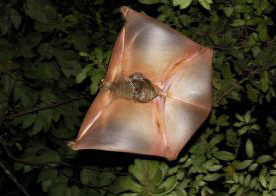Flying lemurs are primates’ closest cousins
Flying lemurs are primates’ closest cousins
mongabay.com
November 1, 2007
New molecular and genomic analysis shows that flying lemurs are the closest relatives of primates, according to research published in the journal Science.
The question over which of several mammalian groups is the closest relative to primates has been hotly debated over the past decade. Some scientists have suggested that the group Scandentia, which includes the small tree shrew, while others have argued for dermopterans, a group that includes two living species of colugos — more popularly known as flying lemurs, though they cannot fly (they glide) and are not lemurs.
Until now there were three leading hypotheses on the relationship between the groups.
 Colugos glide from tree to tree in Malaysia forests using their special skin fold, or patagium, for support. This mother and baby (Cynocephalus variegatus) looks like a living kite but is closely related to primates, the order of mammals that includes lemurs, monkeys, apes, and humans. Credit: Norman Lim, National University of Singapore |
“The ‘Primatomorpha hypothesis’ is that colugos and primates together comprise a single group, the Primatomorpha, which separated evolutionarily from a common ancestor with the tree shrew group,” explained a statement from Penn State University, which was involved in the research. “A second hypothesis is that tree shrews and colugos — inhabiting the geographic region known as Sunda and having many features in common — are more closely related to each other than to primates. Thus, in this ‘Sundatheria hypothesis,’ primates split off from the sundatherians, which later subdivided into scandentians and dermopterans. The third hypothesis is that primates are most closely related to tree shrews alone, with colugos being more distant from both, which can be called the ‘tree shrew hypothesis.'”
“We decided to design an exacting study that would test the three hypotheses using two independent molecular approaches,” said Penn State’s Webb Miller, a professor of biology and computer science and engineering. “Before evaluating the different hypotheses, we wanted to make sure that the Euarchonta was, indeed, a valid evolutionary group that had arisen from a single ancestral lineage.”
“In short, these molecular data strongly suggest that colugos are the sister group to primates,” he continued. “Based on these data, the most probable phylogeny is that the Euarchonta arose as a distinct taxonomic group at 87.9 million years ago — during the heyday of the dinosaurs, more than 20 million years before they went extinct.”
Miller says the finding that colugos are closely related to primates makes them more important as research subjects.
This article is based on a news release from Penn State.
J.E. Janecka et al (2007). Molecular and Genomic Data Identify the Closest Living Relative of Primates. Science Nov 2, 2007.